Meet Sean, a bloke from Brighton, South Australia who loves his gadgets as much as his missus loves their new spa. Despite 8kW of solar panels, Sean had an energy bill that’d make a grown man cry. So, what did he do? Buckled down, got smart, and supercharged his battery setup. Here’s the lowdown:
Two Powerwalls Better Than One?
Sean’s roof is already full of solar panels. So, when his winter bills soared like a homesick angel, he doubled down on battery storage with a second Tesla Powerwall.
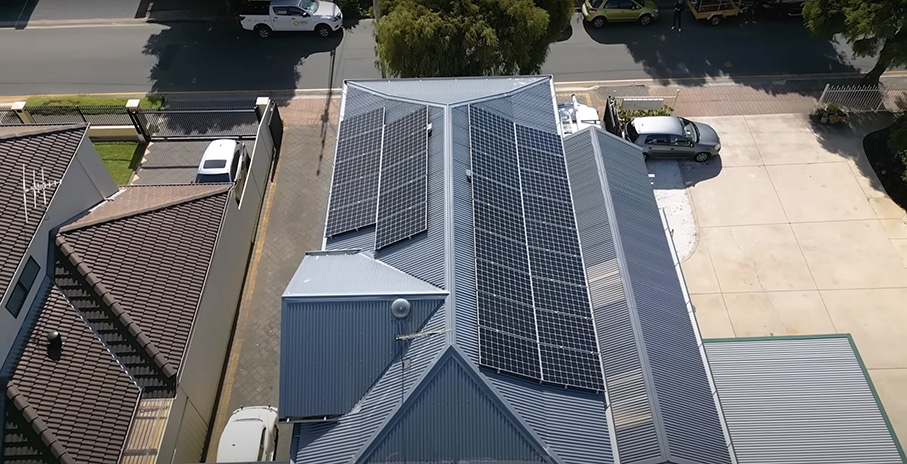
His roof is maxed out with solar panels.
But Can Two Batteries Even Get Enough Juice?
In Adelaide, the winter sun has only a third of the summer’s punch, so Sean’s 8kW of solar power capacity is not enough to fill Sean’s second Powerwall all year round.
In Adelaide, my solar and battery calculator shows his system’s estimated generation profile:
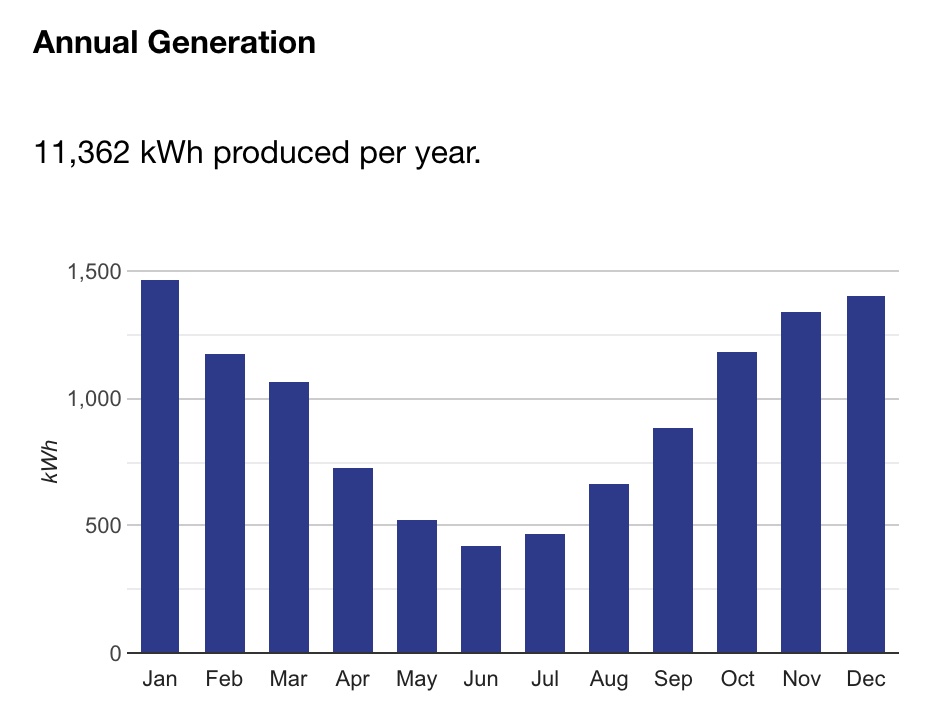
In June, Sean can expect an average of 14kWh daily solar energy generation.
With 16kWh average daily solar electricity generation from May to July, 8kW of East/West panels won’t cut it when filling 27 kWh of Powerwalls.
Enter electricity retailer IO Energy’s “Solar Sponge” tariff.
What’s A Solar Sponge Tariff?
With solar power’s enduring popularity in Australia, our electricity grid has a problem. There’s loads of solar energy generation in the middle of the day – often when the grid doesn’t need it.
One solution is ‘solar sponge’ plans: dirt-cheap off-peak electricity rates in the middle of the day offered by some retailers including IO Energy here in South Australia. When there’s not enough sun, Sean can top up his batteries with super-off-peak grid electricity at only 8 cents per kWh.
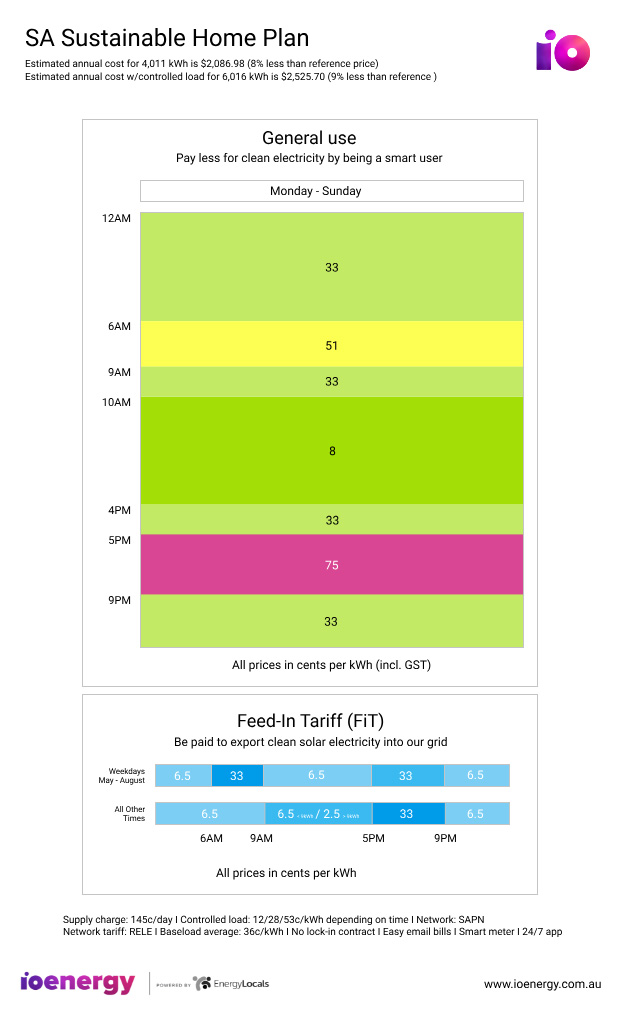
8c per kWh from 10 am-4 pm
But while midday rates are lower than a kangaroo’s belly, come 5 pm the rate skyrockets to a jaw-dropping 75c per kWh. Dodging this peak rate isn’t just smart; it’s bloody essential. The 6 am to 9 am rate of 51 cents is pretty nasty, too. Thankfully, the Powerwall’s control software knows to intelligently charge and discharge to avoid these peaks whilst keeping Sean’s electricity bill as low as possible.
Adding a Second Powerwall: Easier Than The First
It’s pretty straightforward; just stack ’em, connect ’em, run power from the battery to the main supply, and rejig the switchboard. Installation took a little longer than watching ‘The Castle’—four and a half hours. Check out the video above or on Youtube if you want to see the installers at work.
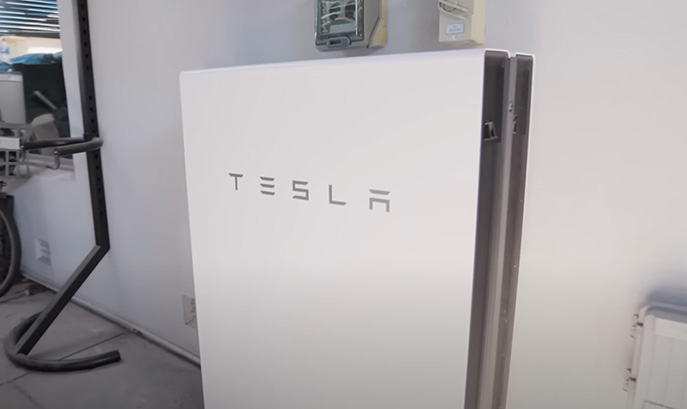
Powerwall 2s stack together neatly.
Teething Issues: Sorted
Two Powerwalls can charge at a maximum rate of 10kW (5kW each). Sean’s home has a maximum grid draw of approximately 14kW (63 amps).
Within the first week of installation, Sean was charging his Powerwalls at full whack (10kW) while using over 4kW of house power. His breaker tripped.
The solution was dynamic load balancing. Tesla remotely configured the Powerwall to monitor the total grid draw and ramp the battery charging power in real-time, so Sean’s house never pulls more than 14kW. Smart.
The Dollars And Cents: Sean’s Electricity Bills
Sean’s winter bills dropped by 57.1%.
No Solar Sponge, No Savings
Without the Solar Sponge tariff, the second Powerwall battery would have been pointless. Not one day in June did Sean get enough solar power to charge both batteries – never mind cover his daytime loads:
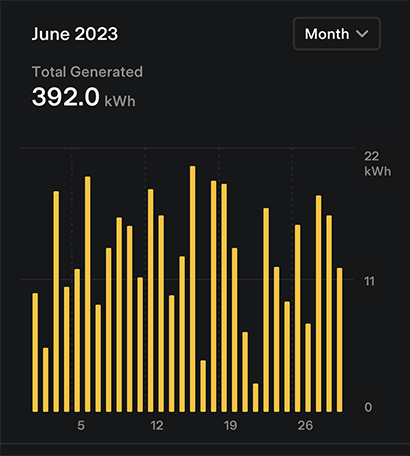
Solar monitoring on the Tesla app
Tesla’s App: Brilliant
Sean uses the Tesla app to keep everything running smoothly. Just plug in your rates and let Tesla do the hard yards.
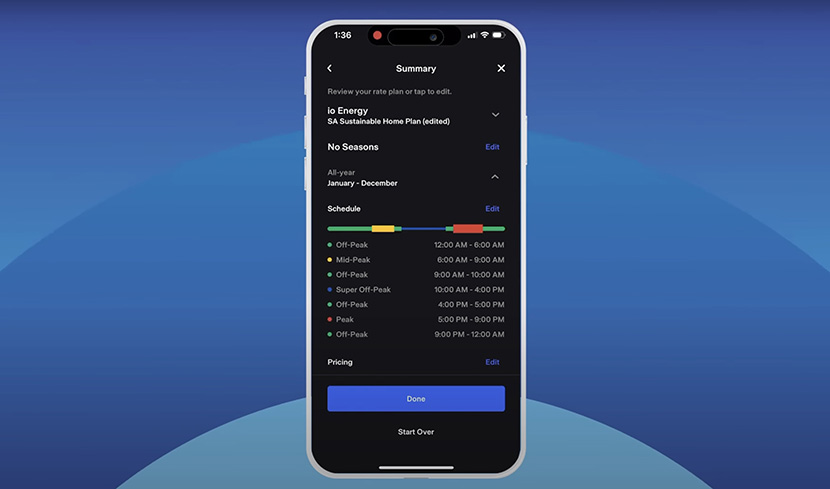
Load in your tariff – and Tesla does the rest
The result? Sean’s dodging the peak pricing periods entirely:
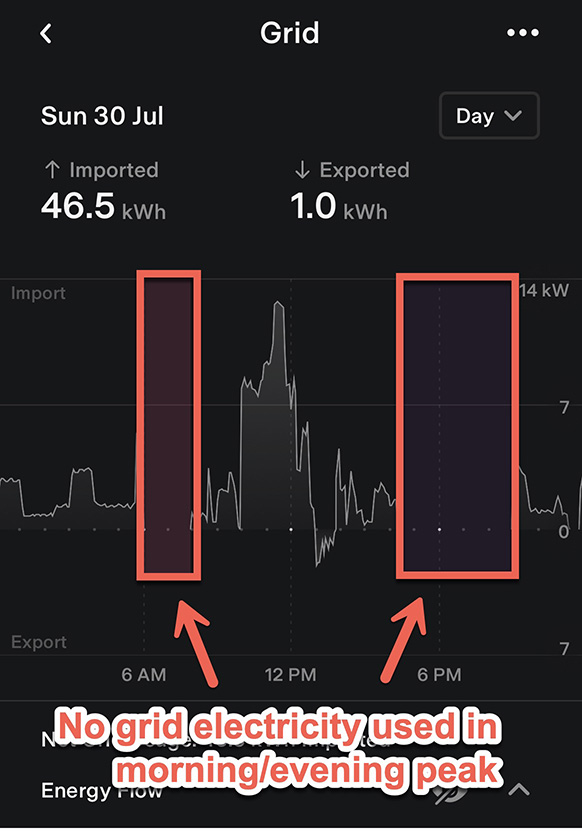
Zero grid imports during peak pricing periods
A Second Powerwall Costs Less Than The First
At the time of writing, a single Tesla Powerwall costs about $15,500 installed.
Over $2k of this cost is the Tesla Gateway and its installation. But you only need one gateway for every ten Powerwalls, so it cost Sean $13k to add his second Powerwall.
Wrapping Up – What Have We Learned?
Solar Sponge tariffs (currently available in WA, SA and QLD) are a big deal. They tend to have vicious peak pricing periods. If you’re considering one, ensure you have an appropriately sized battery.
Tesla’s control software is one of the hidden benefits of its battery. It just works – as demonstrated by Tesla remotely enabling dynamic load balancing.
Finally – some of you may be thinking that with dirt-cheap solar sponge rates, you don’t need a solar power system – only home batteries.
If you can’t get a solar power system installed (due to shading or other issues), you could add batteries, switch to a solar sponge tariff, and run off other people’s cheap solar. Ronald has analysed this option in Western Australia.
I’ll check in with Sean next year to see the full-year impact on his bills.

 RSS - Posts
RSS - Posts



This is tempting as our solar panels are shaded by trees for much of winter. However, the payback period for the 2nd Powerwall would likely be a very long time (if at all).
There is a comparison of “solar sponge” rates here:
https://wattever.com.au/compare-solar-sponge-plans/
However the “off peak” rates seem high.
I live in an apartment subject to heritage restrictions. We are not allowed to have solar collectors. In 2020 I invested in a Tesla powerwall 2 that cost me $7,800 including a rebate of $6,000. I signed up with IOenergy and have kept a spreadsheet of my daily usage since then. After nearly three years I have saved almost $6,000. At the present time 98% of my electricity from the grid is costing 8c per kw/hr. The battery is fully charged between 10am and 4 pm and runs the apartment for the remainder of the day.
I was told I needed to put in a different Gateway to add a second PW2 Battery.
I’ve had the PW2 for about 4 years now
Does this sound right?
no – they should be able to share the same gateway
TKS for article Finn.
As a SA resident with a soon to be redundant legacy 1.5kW system with a 50c FIT, I have been researching the option of using IOE’s 8c Solar Sponge tariff with a PW2 & without Solar panels.
I can’t see the point of installing more Solar panels when many people are still doing this – sorry SQ – & making the Grid here more unstable. As reported this has forced Network Manager SAPN to come up with innovative ways to curtail the growing oversupply but I suspect they will be playing catchup for the foreseeable future.
It is clear to me the lack of Solar panels in this case does improve the payback figures but it would depend on having sufficient battery capacity to cover the Peak period at least & individual useage.
Hopefully I expect more innovative electricity retailers to step up to offer some tariff competition in this solar sponge time slot.
A couple of additional benefits I can see for the 8c tariff are cheap Hot Water heating & A/C use all year round.
Also if a home has a lower than expected use profile during the evening Peak period one could export some of that spare battery capacity back to the Grid to make use of IOE’s 33c FIT between 5pm & 9pm daily.
A nice bit of price arbitrage – buy it for 8c during the day & sell it back to the same retailer for 33c in the evening – this would also help to offset IOE’s relatively high Daily Service charge of $1.45.
My daily supply charge is $2.13. Wish it was only 1.45
Actually, it can be even better than this. We recently switched to Amber Energy. They sell us power at wholesale variable rates plus a service fee of $19 a month. When the grid is full of solar, the wholesale cost often goes negative. We get paid to use power. This is when the battery comes into it’s own. Fill the battery when variable rate (not 8c fixed) is low or even negative. Use it at peak periods, or re sell the power to the grid when the FIT (also variable) is high. Repeat. And the Tesla app will do most of this for you.
Out of interest Fred, which part doesn’t the Tesla do for you? I’d be a bit paranoid if there’s some anomaly event during a random day, and you’re suddenly paying huge wholesale rates but don’t know until later? Do you have to sit and monitor it during the times you’re charging up?
The App that comes with Amber shows both real time wholesale pricing and forecasts for the day. It will send you message notifications for variations you can set in the app. My understanding is that Amber plus Power Wall can be set to do that automatically, again with you setting the parameters. When the FIT goes negative, if we are not using much solar, we turn the pool on…. Again that remote. Settled in now I’d check what’s happening around 11am, and then only again at 3pm when the poles and wires charges go to peak.
Hi Finn, thanks for all the useful info that you provide.
I am considering going down a similar route, installing a Powerwall2 while being unable to have solar panels.
It’s probably a fairly basic question, but: after charging the battery during daylight hours, will I be able to use stored power from the battery for home load (during afternoon peak, as an example) and feed back into the grid at the 33c FiT rate, at the same time (battery feeding into grid and feeding home load requirements at the same time).
Thanks!
Hi J,
If you have a look at a retailer like Amber they may be able to tell you how they control things like this with Tesla & other brands
Hmm, here we are over a year later, and this one came up in a recent blog article as ‘related’.
I am wondering if the AGL EV Night Saver rate (8c per khw 0000-0600) can also be used to charge up a battery during those hours if needed in dead of winter ?
Those really bad days with dark grey cloud skies and constant rain.
Have a recent 11.23kw system SolarEdge optimised on 2 phases, and in SA with the highest peak tariff and lowest FIT, now being lowered 33.3% from Nov 1, 2024.
I’m sending 65% production to grid in winter, near 90% approaching first full summer, and think by the time autumn rolls around, I’d like to get a suitable battery and likely the new 6 channel Catch Control to really look after the whole shebang.
Hi, can I check if this is a single phase system? My installer is telling me that with a second powerwall 2 and the one gateway, I can only charge and discharge at 5kw.
Hi Shaun,
Powerwalls are a single phase device, but to my knowledge they can be paralleled to offer more peak output. In Sean’s instance he had to get the Powerwalls programmed to share incoming power from the grid because when they’re charging at 5kW each (10kW total) additional ordinary house loads can pop the service fuse rated for 14.5kW
The only time you need a second gateway is if you’re backing up a second phase on a 2 or 3 phase property.
Thanks for the quick reply Anthony. I will ask my installer to get a second opinion!
Hi Finn,
Can you advise?
I have 10kwh of PV on the roof. Two Fronius inverters. A PW2. Installed just under four years ago.
With the new battery rebate, I thought I’d add a second PW2 (if there’s one left). I rang my original installer. They said not possible, I’d be exceeding my inverter limit. What?
Can you explain this in terms that I’d understand please? I’m in Victoria and Citipower is the supplier.
Cheers,
Haig
Hi Haig,
There’s 17 DNSPs so I don’t claim to know all the rules but the basics are here: https://www.solarquotes.com.au/grid-connection/vic/#citipower
We need a bit more info about your setup. The PW2 has a 5kW inverter on board. Are both your Fronius units 5kW each?
Do you have 3 phase?
https://www.solarquotes.com.au/blog/kw-and-kwh-what-is-the-difference/?
Greetings Anthony, thanks for getting back.
I have two Fronius Primo 5.0 inverters. I’m assuming they are 5kwh rated. I don’t really know sorry. I’ve learned more about solar since having my system for four years, some of the jargon and technical terms are starting to make sense. But some still remains a mystery.
The house is on single phase, I should have said that at the beginning.
Hi Haig,
To add some jargon in the name of clarity, I should mention that kilowatts is abbreviated to kW but it would be better if it was kWp… with p standing for peak.
Your inverter is rated for instantaneous production or peak throughput of 5kWp Your array on the roof is rated for kilowatts peak output, which is nominal at 25ºC, so they will actually do more when it’s sunny and cold.
So ignoring losses, if your array gets 5kW of insolation, and the Fronius can turn that into 5kW of output and if they keep it up consistently for a whole hour… then you have 5kWhours of yield.
kWh are the units you’re billed for and the units stored in your battery.
If you have 5kW + 5kW of solar inverter then I imagine you’re at maximum approved generator capacity.
Some DNSPs allow a further 10kW of battery inverter but they can also view a hybrid as counting toward both allowable totals.
In SAPN land you could add another PW2, or throttle a PW3 possibly, but it would be ineligible for solar.
Best ring Citipower and ask them if they’ll let you have more?
Thanks Anthony. I have to say that I’m constantly surprised at how hard it all is. How on earth is it going to work once I have V2x car? I thought that would be the future for the whole network. Alas Powercor will no doubt stop me from plugging in a bidirectional device.
Just a follow-up.
Apparently they can now add another PW2. Apparently there is room, switchboard is fine etc.
But they want $16k to do it (before rebate). Nah.
I have gone the exact same route, 4 years ago 8kw of solar, 2 years ago a single tesla powerwall ($13,500) with OVO, which tops up from solar and free 11am-2pm, but it doesn’t really see us right through the night, often tapping out at 8pm in the winter and we’re now paying significant heating bills.
With the addition of a 2nd powerwall ($9,000) with rebates, we hope to have enough power to see us right through as well as be able to send 10kw in either direction, meaning we can add our 8kw air con to the backup circuits… we’d have a fairly good stab at staying off grid entirely in the summer months.
I can see this would give us an opportunity to stay fairly full of power until the sun wanes ~4pm and we may have some left to export at peak prices in the future.
So a couple of gotchas though, we also are on single phase – but the fuse says 80A, the breaker is 63A – and the PW itself is on 32A breaker, needs upgrading for 10kw in/out to the stack? going in TOMORROW>